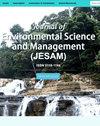芭蕉纤维(Musa textilnee)和塑料消费后废物(A/PCW)作为潜在的建筑材料
IF 0.3
4区 环境科学与生态学
Q4 ENVIRONMENTAL SCIENCES
Journal of Environmental Science and Management
Pub Date : 2020-12-27
DOI:10.47125/jesam/2020_sp1/02
引用次数: 3
摘要
本研究提出了将消费后的柔性塑料废弃物与abaca (A/PCW)结合使用,作为一种潜在的建筑工业复合板。采用简单的物理-机械工艺,利用S2级橡胶树纤维和柔性塑料PCW制成复合板,成为潜在的建筑材料。因此,本研究基于A/PCW复合材料的物理力学性能来研究其最佳性能配方。3种A/PCW样品,每种样品制备6个标本。这些是样品1、2和3,分别有50:50、60:40和70:30的重量:重量比。采用Abaca纤维S2级与聚对苯二甲酸乙二醇酯(PET)制成的PCW, PET与金属化铝结合R10-103剂制成复合板。样品2在样品中表现最好,其物理和机械性能得到了最大的改善。应用SPSS统计工具中的方差分析(ANOVA)。结果支持并证实了实验分析。本文章由计算机程序翻译,如有差异,请以英文原文为准。
Abaca Fiber (Musa textilis Nee) and Plastic Post-Consumer Wastes (A/PCW) as Potential Building Material
This study presents the utilization of flexible plastic post-consumer wastes combined with abaca (A/PCW) as a potential composite board for building industry. Employing a simple physico-mechanical process using S2 grade abaca fiber and flexible plastic PCW which produced composite board potential for building materials. Hence, the study investigated the best performing formulation of A/PCW composite based on its physical and mechanical properties. Three types of A/PCW samples with six specimen were prepared for each type. These are Sample 1, 2 and, 3 which has 50:50, 60:40, and 70:30 wt:wt ratio, respectively. Abaca fiber grade S2 with PCW made of polyethylene terephthalate (PET), and PET with metalized aluminium bonded with R10-103 agent were used to form a composite board. Sample 2 performed best among the samples by recording the most improved physical and mechanical properties. Analysis of Variance (ANOVA) in Statistical Package for the Social Sciences (SPSS) statistics tool was applied., The results supported and confirmed the experimental analyses.
求助全文
通过发布文献求助,成功后即可免费获取论文全文。
去求助
来源期刊

Journal of Environmental Science and Management
ENVIRONMENTAL SCIENCES-
CiteScore
0.90
自引率
0.00%
发文量
10
审稿时长
2 months
期刊介绍:
The Journal of Environmental Science and Management (JESAM) is an international scientific journal produced semi-annually by the University of the Philippines Los Baños (UPLB).
JESAM gives particular premium to manuscript submissions that employ integrated methods resulting to analyses that provide new insights in environmental science, particularly in the areas of:
environmental planning and management;
protected areas development, planning, and management;
community-based resources management;
environmental chemistry and toxicology;
environmental restoration;
social theory and environment; and
environmental security and management.
 求助内容:
求助内容: 应助结果提醒方式:
应助结果提醒方式:


